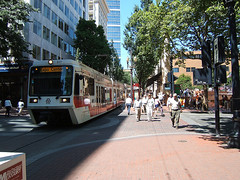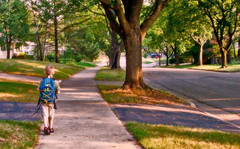Sidewalks are good for your health – and so are neighborhood amenities

Posted May 1, 2009 at 1:27PM
A large new international study published in the American Journal of Preventive Medicine demonstrates that the presence of sidewalks and other nearby amenities increases physical activity and fitness among neighborhood residents.
In particular, increased physical activity was significantly associated with five of the variables tested:
- Sidewalks on most streets
- Transit stop in neighborhood
- Many shops nearby
- Bicycle facilities
- Low-cost recreational facilities
No significant association was found with two other variables, perceived crime and the presence of single-family houses (tested as a proxy for residential density).
 The presence of sidewalks was found to have the highest association with physical activity, and the study also found that the presence of three or more of the significant environmental factors was associated with a higher degree of exercise than was the presence of only one factor: "Although single attributes were associated with 15%-50% higher rates of meeting guidelines, when all six built environment attributes were present, rates of physical activity were 100% higher, compared to those in neighborhoods with no supportive attributes." When the study was controlled for variations in levels of education, neighborhoods with multiple attributes continued to outperform those without in encouraging physical activity.
The presence of sidewalks was found to have the highest association with physical activity, and the study also found that the presence of three or more of the significant environmental factors was associated with a higher degree of exercise than was the presence of only one factor: "Although single attributes were associated with 15%-50% higher rates of meeting guidelines, when all six built environment attributes were present, rates of physical activity were 100% higher, compared to those in neighborhoods with no supportive attributes." When the study was controlled for variations in levels of education, neighborhoods with multiple attributes continued to outperform those without in encouraging physical activity.
Researchers looked at data from 11,541 survey participants in 11 countries, which included the United States Lithuania, Brazil, Sweden and Japan. They considered it enough exercise if individuals reported doing moderate-to-vigorous activity at least five days a week for at least 30 minutes each day.
Here is a particularly sad finding:
"The U.S. had the most limited access to transit stops and was the only country in which less than 60% of participants were within walking distance of shops. These findings help explain the small percentage of trips made by walking and bicycling in the U.S."
"Our study had a great deal of variation in neighborhoods," said lead author James Sallis, Ph.D., a professor at the State University of San Diego. "We found that amenities were strongly related to exercise levels, even in this group of culturally very diverse countries."
Go here for the Journal's news page, here for the press release, and here for the study itself.
Jim Sallis has been researching the relationship between active living and the built environment for some time, and also led the long-term Neighborhood Quality of Life study, which was funded by a $2 million grant from the National Institutes of Health and evaluated 32 communities in the Seattle and Baltimore regions, starting in 2001. The final results of the study found that people living in "high-walkable" communities get substantially more exercise than those living in "low-walkable" areas. Here's a short video clip ("Your Neighborhood Can Make You Fat") about the study that ran on San Diego's NBC affiliate:

